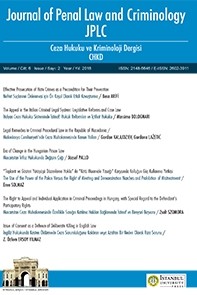Kısmi Hafıza: Kapsamlı Yüzleştirmeye Başvurulması için Bir Başka Neden mi?
Partial Memory: Another Reason for using Large Lineups?
Introduction: The 48-person lineup has been found to decrease substantially mistaken identifications, with little cost to correct ones. The goal of this experiment was to increase correct identifications.
Keywords:
Eyewitness identification, 48-person lineups partial memory,
___
- Robert Buckhout, ‘Eyewitness memory’ (1974) 231 Scientific American 23.
- Steven E Clark, ‘A Re-examination of the Effects of Biased Lineup instructions in eyewitness identification’ (2005) 29 Law and Human Behavior 575.
- Edward Conners, Thomas Lundregan, Neal Miller and Tom McEwen,. Convicted by juries, exonerated by science: Case studies in the use of DNA evidence to establish innocence after trial (U. S. Department of Justice 1996).
- Stephen Darling, Tim Valentine, and Amina Memon, ‘Selection of lineup fillers in operational contexts’ (2008) 22 Applied Cognitive Psychology 159.
- Anthony N Doob and Herschi M Kirshenbaum, ‘Bias in police lineups-partial remembering’ (1973) 1 Journal of Police Science and Administration, 287.
- Avraham M Levi, ‘Are defendants guilty if they were chosen in a lineup?’ (1998) 22 Law and Human Behavior 389.
- Avraham M Levi, ‘An Analysis of Multiple Choices in MSL Lineups, and a Comparison with Simultaneous and Sequential ones’ (2006a) 12 Psychology, Crime, & Law 273.
- Avraham M Levi, ‘A Comparison Between Large Simultaneous and MSL Lineups, with Photos Viewed in Sets of Six’ In K Nixon (Ed.) Forensic recall and eyewitness testimony (A-IP Publishing 2006b).
- Avraham M Levi, ‘Evidence for Moving to an 84-Person Photo Lineup’ (2007) Journal of Experimental Criminology 377.
- Avraham M Levi, ‘Much Better than the Sequential lineup: A 120-person lineup’ (2012) 18 Psychology, Crime & Law 631.
- Avraham M Levi, ‘When the relative judgment theory proved to be false’ (2015) 5 Psychology and Law 141.
- Avraham M Levi, ‘Comparing the English Video Lineup with the 48-Person Lineup’ (2017) 5 Universal Journal of Psychology 239.
- Roberto Cameron Lodge Lindsay and Gary L Wells, ‘Improving eyewitness identifications from lineups: Simultaneous versus sequential lineup presentation’ (1985) 70 Journal of Applied Psychology 556.
- Clara Alison Elizabeth Luus and Gary L Wells, ‘Eyewitness identification and the selection of distracters for lineups’ (1991) 15 Law and Human Behavior 43.
- Roy S Malpass and Patricia G Devine, ‘Eyewitnes identification: Lineup instructions and the absence of the offender’ (1981) 66 Journal of Applied Psychology 482.
- Steven Penrod Eyewitness guessing and choosing (Sarmac Conference, Bethel College, Maine 2006).
- Sean Pryke, RCL Lindsay, JE Dysart and P Dupuis, ‘Multiple independent identification decisions: A method of calibrating eyewitness identifications’ (2004) 89 Journal of Applied Psychology 73.
- Barry Scheck, Peter Neufeld, and Jim Dwyer Actual innocence: When justice goes wrong and how to make it right (Signet 2001).
- Nancy M Steblay, ‘Social influence in eyewitness recall: A meta-analytic review of lineup instruction effects’ (1997) 21 Law and Human Behavior 283.
- The State of Israel v. Kedoshim, Tel Aviv District Court 40371 (2001) Tim Valentine, Alan Pickering, and Stephan Darling,’ Characteristics of eyewitness identification that predict the outcome of real lineups’ (2003) 17 Applied Cognitive Psychology 969.
- Walpole, Ronald E. Introduction to Statistics (Macmillan 1968).
- Gary L Wells, Mark Small, Steven Penrod, Roy S Malpass, Solomon M Fulero, and Clara Allison Elizabeth Brimacombe, ‘Eyewitness identification procedures: Recommendations for lineups and photospreads’ (1998) 22 Law and Human Behavior 603.
- Gary L Wells, Andrew M Smith and Laura Smalarz, ‘ROC analysis of lineups obscures information that is critical for both theoretical understanding and applied purpose’ (2015) 4 Journal of Applied Research in Memory and Cognition 324.
- ISSN: 2148-6646
- Yayın Aralığı: Yılda 2 Sayı
- Başlangıç: 2014
- Yayıncı: Adem Sözüer/ Rahime ERBAŞ
Sayıdaki Diğer Makaleler
Türkiye’de Öldürme Eğilimleri: Kamuya Açık Verilerin bir Değerlendirmesi
Gıda Ceza Hukukunun Bazı Temel Kavramları ve Genel Yapısı Üzerine Mukayeseli Bir İnceleme
Güney Doğu Avrupa’da Şiddet İçeren Aşırılığa İten Güçler – Kuzey Makedonya Bağlamı
Kısmi Hafıza: Kapsamlı Yüzleştirmeye Başvurulması için Bir Başka Neden mi?
